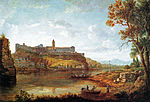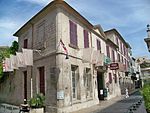Collegiate Church of Notre-Dame, Villeneuve-lès-Avignon
14th-century Roman Catholic church buildings in FranceChurches in GardCollegiate churches in FranceFrench church stubsGothic architecture in France ... and 1 more
Monuments historiques of Gard

The Collegiate Church of Notre-Dame (French: Collégiale Notre-Dame) is a Gothic church in Villeneuve-lès-Avignon, Gard, Occitanie, France.
Excerpt from the Wikipedia article Collegiate Church of Notre-Dame, Villeneuve-lès-Avignon (License: CC BY-SA 3.0, Authors, Images).Collegiate Church of Notre-Dame, Villeneuve-lès-Avignon
Rue de l'Hôpital, Nîmes
Geographical coordinates (GPS) Address External links Nearby Places Show on map
Geographical coordinates (GPS)
| Latitude | Longitude |
|---|---|
| N 43.9633 ° | E 4.79665 ° |
Address
Collégiale Notre-Dame de Villeneuve-lès-Avignon (Église Notre-Dame de Villeneuve)
Rue de l'Hôpital
30400 Nîmes
Occitania, France
Open on Google Maps










